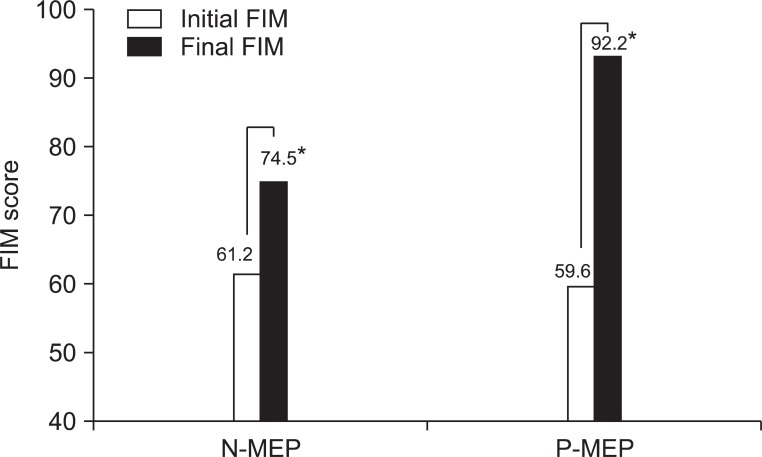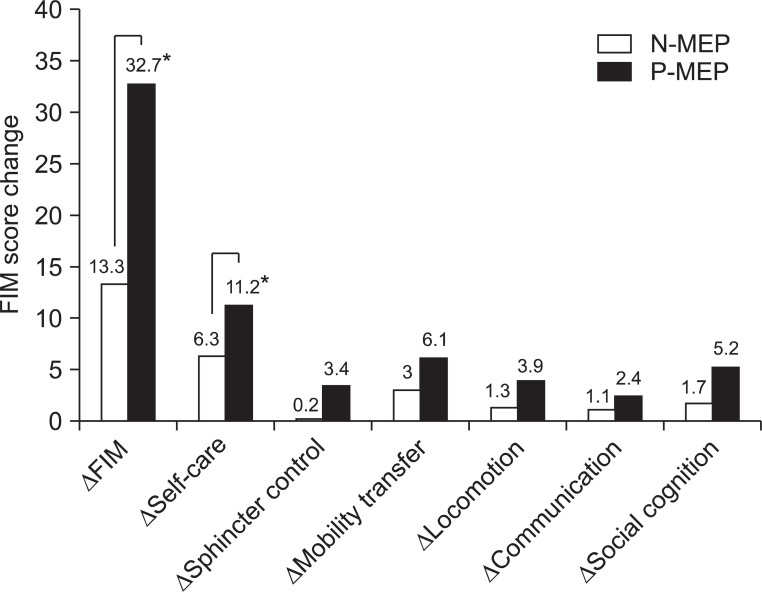Ann Rehabil Med.
2013 Feb;37(1):82-87. 10.5535/arm.2013.37.1.82.
Activity of Daily Living and Motor Evoked Potentials in the Subacute Stroke Patients
- Affiliations
-
- 1Department of Rehabilitation Medicine, Inje University Ilsan Paik Hospital, Inje University College of Medicine, Goyang, Korea. wholespirit@hanmail.net
- KMID: 2266654
- DOI: http://doi.org/10.5535/arm.2013.37.1.82
Abstract
OBJECTIVE
To investigate the effectiveness of the daily living activity and motor evoked potential (MEP) in the subacute stroke patients.
METHODS
Nineteen subjects with subacute ischaemic/hemorrhagic stroke developed in the last three months were enrolled, and MEP was measured with transcranial magnetic stimulation. Functional Independence Measure (FIM) score were evaluated in both groups before and 4 weeks after comprehensive rehabilitative management. According to the presence of MEP response in the affected hemisphere, subjects were divided into MEP positive and negative group.
RESULTS
There was no significant difference between the two groups in age, sex, and post-onset duration. Four weeks later, the change in total FIM and self-care score improved significantly in the MEP-positive group, when compared to the MEP-negative group (p<0.05). However, cognitive improvement had no relationship with MEP responsiveness.
CONCLUSION
We concluded that initial measurement of MEP is a useful assessment tool in predicting functional outcome of subacute stroke patients.
MeSH Terms
Figure
Cited by 3 articles
-
Factors Affecting the Motor Evoked Potential Responsiveness and Parameters in Patients With Supratentorial Stroke
Tae Woong Choi, Seung Gul Jang, Seung Nam Yang, Sung-Bom Pyun
Ann Rehabil Med. 2014;38(1):19-28. doi: 10.5535/arm.2014.38.1.19.Can Motor Evoked Potentials Be an Objective Parameter to Assess Extremity Function at the Acute or Subacute Stroke Stage?
Gi-Wook Kim, Yu Hui Won, Sung-Hee Park, Jeong-Hwan Seo, Myoung-Hwan Ko
Ann Rehabil Med. 2015;39(2):253-261. doi: 10.5535/arm.2015.39.2.253.Association Between Evoked Potentials and Balance Recovery in Subacute Hemiparetic Stroke Patients
So Young Lee, Bo Ryun Kim, Eun Young Han
Ann Rehabil Med. 2015;39(3):451-461. doi: 10.5535/arm.2015.39.3.451.
Reference
-
1. Diamond PT, Felsenthal G, Macciocchi SN, Butler DH, Lally-Cassady D. Effect of cognitive impairment on rehabilitation outcome. Am J Phys Med Rehabil. 1996; 75:40–43. PMID: 8645438.2. Stinear C. Prediction of recovery of motor function after stroke. Lancet Neurol. 2010; 9:1228–1232. PMID: 21035399.
Article3. Chu NS. Motor evoked potentials with magnetic stimulation: correlations with height. Electroencephalogr Clin Neurophysiol. 1989; 74:481–485. PMID: 2480229.
Article4. Curra A, Modugno N, Inghilleri M, Manfredi M, Hallett M, Berardelli A. Transcranial magnetic stimulation techniques in clinical investigation. Neurology. 2002; 59:1851–1859. PMID: 12503582.
Article5. Kang MJ, Yoon TS, Park CI, Shun SI. Motor evoked potential in stroke. J Korean Acad Rehabil Med. 1993; 17:26–35.6. Han TR, Bang MS, Lee KW. Motor evoked potentials of upper and lower extremities by magnetic stimulation in hemiparesis. J Korean Acad Rehabil Med. 1998; 22:386–391.7. Lee JJ, Jung HY. The correlation of hemiplegic upper limb recovery with SEP and MEP in subjects with a stroke. J Korean Acad Rehabil Med. 2008; 32:512–517.8. Lee SY, Lim JY, Kang EK, Han MK, Bae HJ, Paik NJ. Prediction of good functional recovery after stroke based on combined motor and somatosensory evoked potential findings. J Rehabil Med. 2010; 42:16–20. PMID: 20111839.
Article9. Hsieh YW, Wu CY, Lin KC, Chang YF, Chen CL, Liu JS. Responsiveness and validity of three outcome measures of motor function after stroke rehabilitation. Stroke. 2009; 40:1386–1391. PMID: 19228851.
Article10. Granger CV, Cotter AC, Hamilton BB, Fiedler RC. Functional assessment scales: a study of persons after stroke. Arch Phys Med Rehabil. 1993; 74:133–138. PMID: 8431095.11. Hamilton BB, Granger CV. Disability outcomes following inpatient rehabilitation for stroke. Phys Ther. 1994; 74:494–503. PMID: 8171110.
Article12. Kim C, Jeong J. The significance of motor evoked potentials as a prognostic factor in the early stage of stroke patients. J Korean Acad Rehabil Med. 1999; 23:1213–1220.13. Brouwer BJ, Schryburt-Brown K. Hand function and motor cortical output poststroke: are they related? Arch Phys Med Rehabil. 2006; 87:627–634. PMID: 16635624.
Article14. Vang C, Dunbabin D, Kilpatrick D. Correlation between functional and electrophysiological recovery in acute ischemic stroke. Stroke. 1999; 30:2126–2130. PMID: 10512917.
Article15. Jung HY, Kim TH, Park JH. Relationship of National Institute of Health Stroke Scale and motor evoked potentials in subjects with stroke. J Korean Acad Rehabil Med. 2005; 29:563–567.
- Full Text Links
- Actions
-
Cited
- CITED
-
- Close
- Share
- Similar articles
-
- Motor Evoked Potentials and Somatosensory Evoked Potentials of Upper and Lower Extremities for Prediction of Functional Recovery in Stroke
- Association Between Evoked Potentials and Balance Recovery in Subacute Hemiparetic Stroke Patients
- Changes of motor evoked potentials and spinal cord evoked potentials following spinal cord injury in rats
- Motor evoked potential in stroke
- Can Motor Evoked Potentials Be an Objective Parameter to Assess Extremity Function at the Acute or Subacute Stroke Stage?



